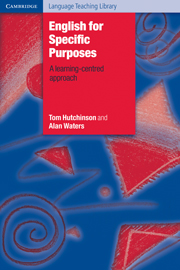Book contents
4 - Language descriptions
Published online by Cambridge University Press: 03 May 2010
Summary
They have been at a great feast of language, and stolen the scraps.
(Shakespeare: Love's Labour's Lost)Any ESP course makes use of explicit or implicit ideas about the nature of language. These ideas are drawn from the various language descriptions that have been developed by succeeding schools of thought in Linguistics. We now have a number of ways of describing language available to us. It is, therefore, important to understand the main features of each of these descriptions in order to consider how they can be used most appropriately in ESP courses. Not all the developments in Linguistics have had pedagogic applications, of course. In this chapter we shall give a brief outline of the various ideas about language that have influenced ESP in some way. We can identify six main stages of development.
Classical or traditional grammar
Although language teaching has a long history stretching back to ancient times (see Howatt, 1984), the ways of describing language remained little changed until this century. Descriptions of English and other languages were based on the grammars of the classical languages, Greek and Latin. These descriptions were based on an analysis of the role played by each word in the sentence. Languages were described in this way because the classical languages were case-based languages where the grammatical function of each word in the sentence was made apparent by the use of appropriate inflections. Thus the form of a word would change according to whether it was a subject, object, indirect object and so on.
Information
- Type
- Chapter
- Information
- English for Specific Purposes , pp. 24 - 38Publisher: Cambridge University PressPrint publication year: 1987
